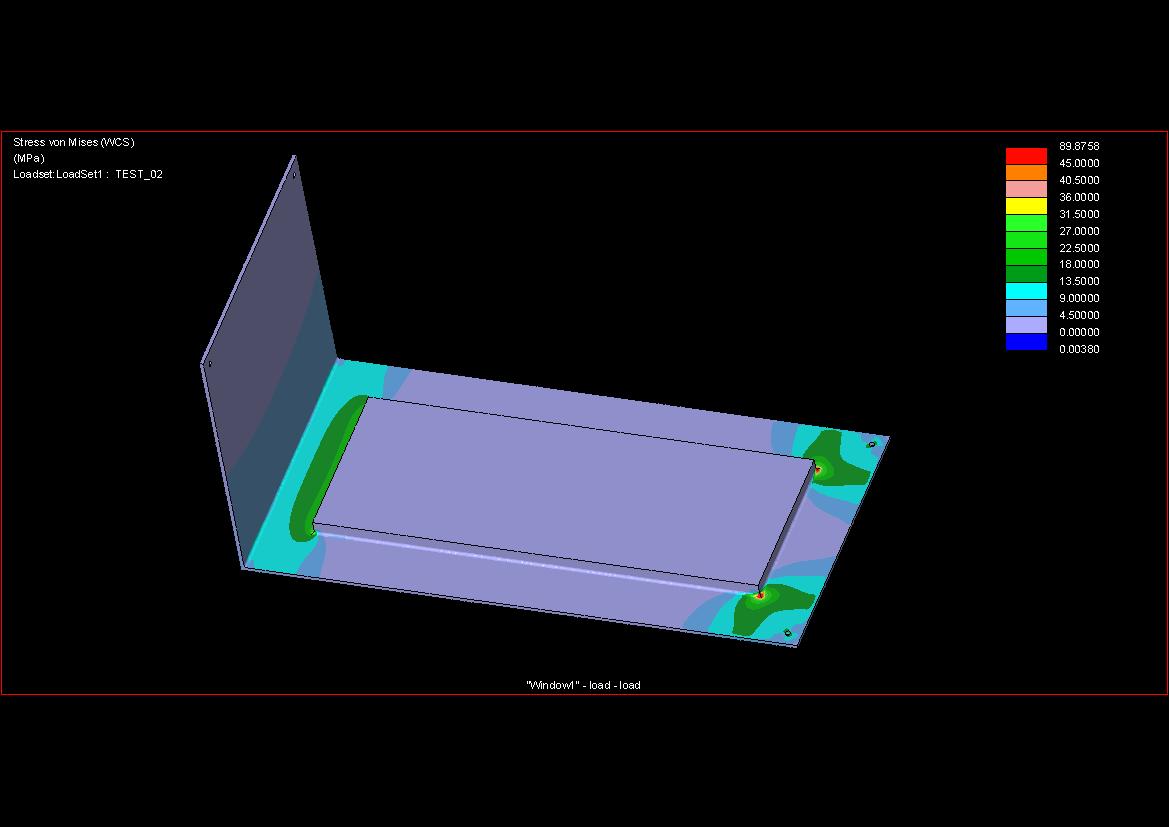Community Tip - You can Bookmark boards, posts or articles that you'd like to access again easily! X
- Community
- Creo+ and Creo Parametric
- Analysis
- Re: weigthed link, unreal simulate results
- Subscribe to RSS Feed
- Mark Topic as New
- Mark Topic as Read
- Float this Topic for Current User
- Bookmark
- Subscribe
- Mute
- Printer Friendly Page
weigthed link, unreal simulate results
- Mark as New
- Bookmark
- Subscribe
- Mute
- Subscribe to RSS Feed
- Permalink
- Notify Moderator
weigthed link, unreal simulate results
Hello there,
Here is the thing, I have a frame that I want to analize under load while it is lifted, for that puspose I set a weighted link constrain, so that the frame is "hanged" and the load applied.
Now, in order to stabilize it I added a soft spring (5 in lb ) at each corner, i used a ground spring,
See picture attached
ok, once the results are gotten the displacement is up to 1929 Inches which means that weighted link is not working, it seems that just the srpings are sopporting the frame and the load.
you will see also, that the stresses are generated at the spring connection
Does anyone knows why is this issue?
I really appreciate any help on this
Best regards
Solved! Go to Solution.
- Labels:
-
General
Accepted Solutions
- Mark as New
- Bookmark
- Subscribe
- Mute
- Subscribe to RSS Feed
- Permalink
- Notify Moderator
- Mark as New
- Bookmark
- Subscribe
- Mute
- Subscribe to RSS Feed
- Permalink
- Notify Moderator
ok, see pictures this way
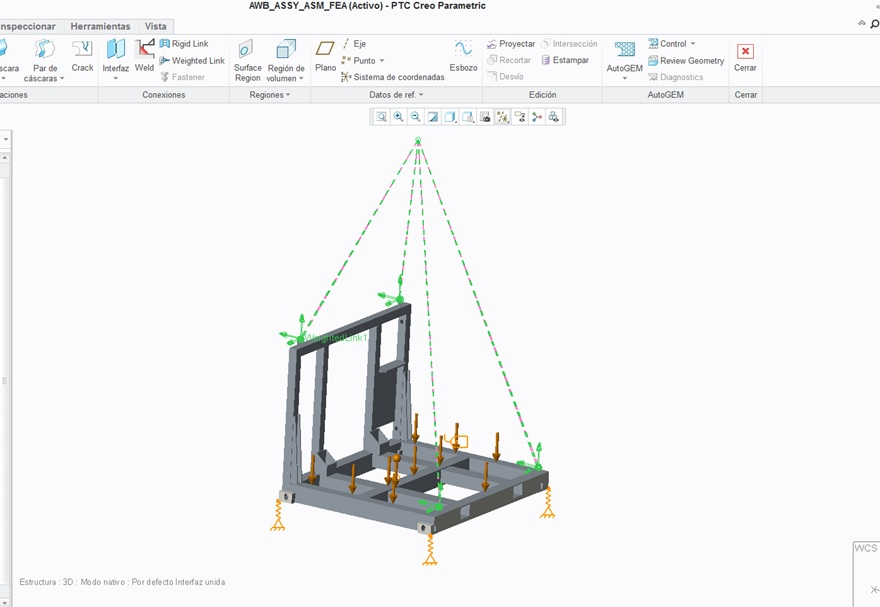
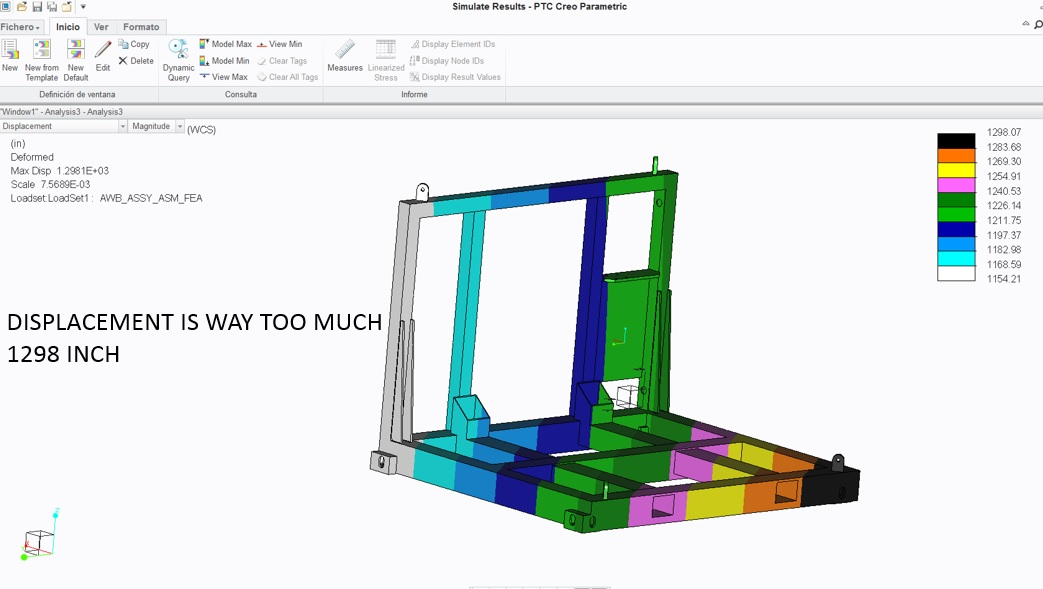
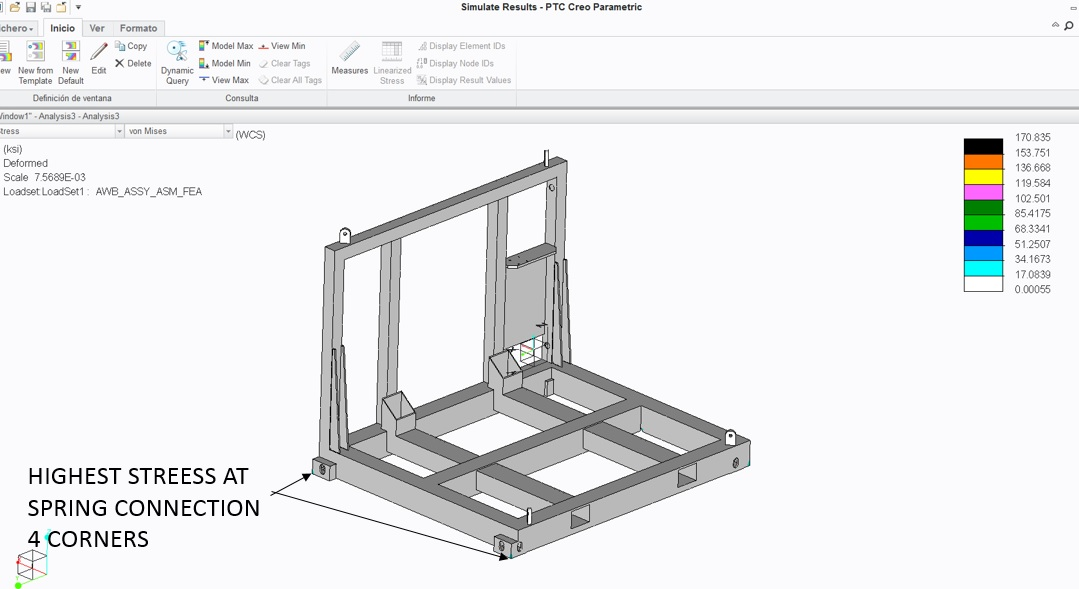
- Mark as New
- Bookmark
- Subscribe
- Mute
- Subscribe to RSS Feed
- Permalink
- Notify Moderator
A weighted link passes displacement from the independent (multiple) side to the dependent point, but will only pass force in the other direction. To use it for constraint, you need to attach a spring to the dependent point (to convert the displacement to force) and constrain the other end of the spring.
- Mark as New
- Bookmark
- Subscribe
- Mute
- Subscribe to RSS Feed
- Permalink
- Notify Moderator
- Mark as New
- Bookmark
- Subscribe
- Mute
- Subscribe to RSS Feed
- Permalink
- Notify Moderator
alright few things.
in your example, I just see the dependet side (top point for weighted link) and the independent points (4 corners attached)
if I tried to run it it just doesn not run, it says insufficiently constrained..
ok going back to my application, this is what I did
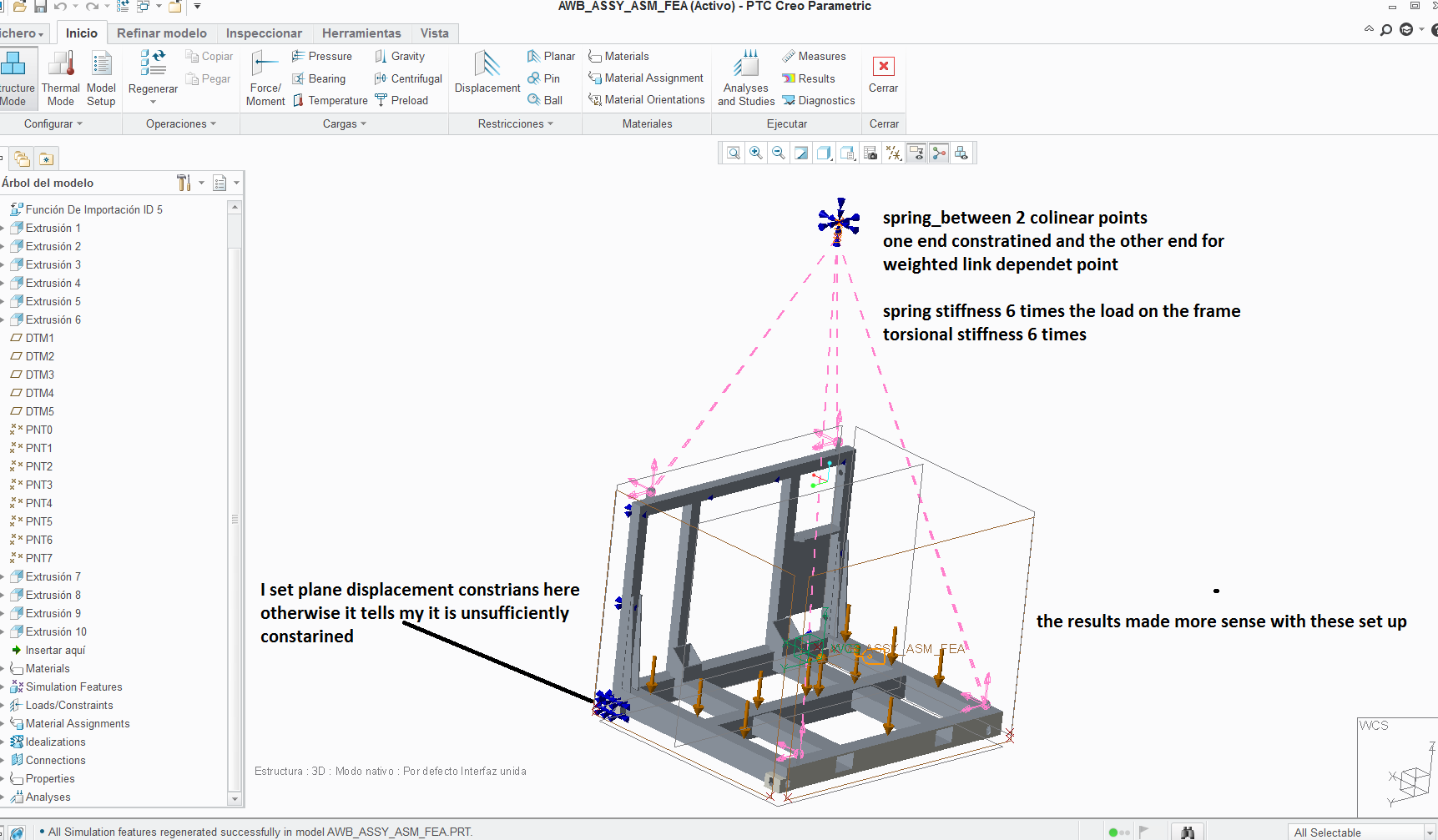
I wonder why it does not run without the planar constrains?
if I place springs at the corners the results are unreal
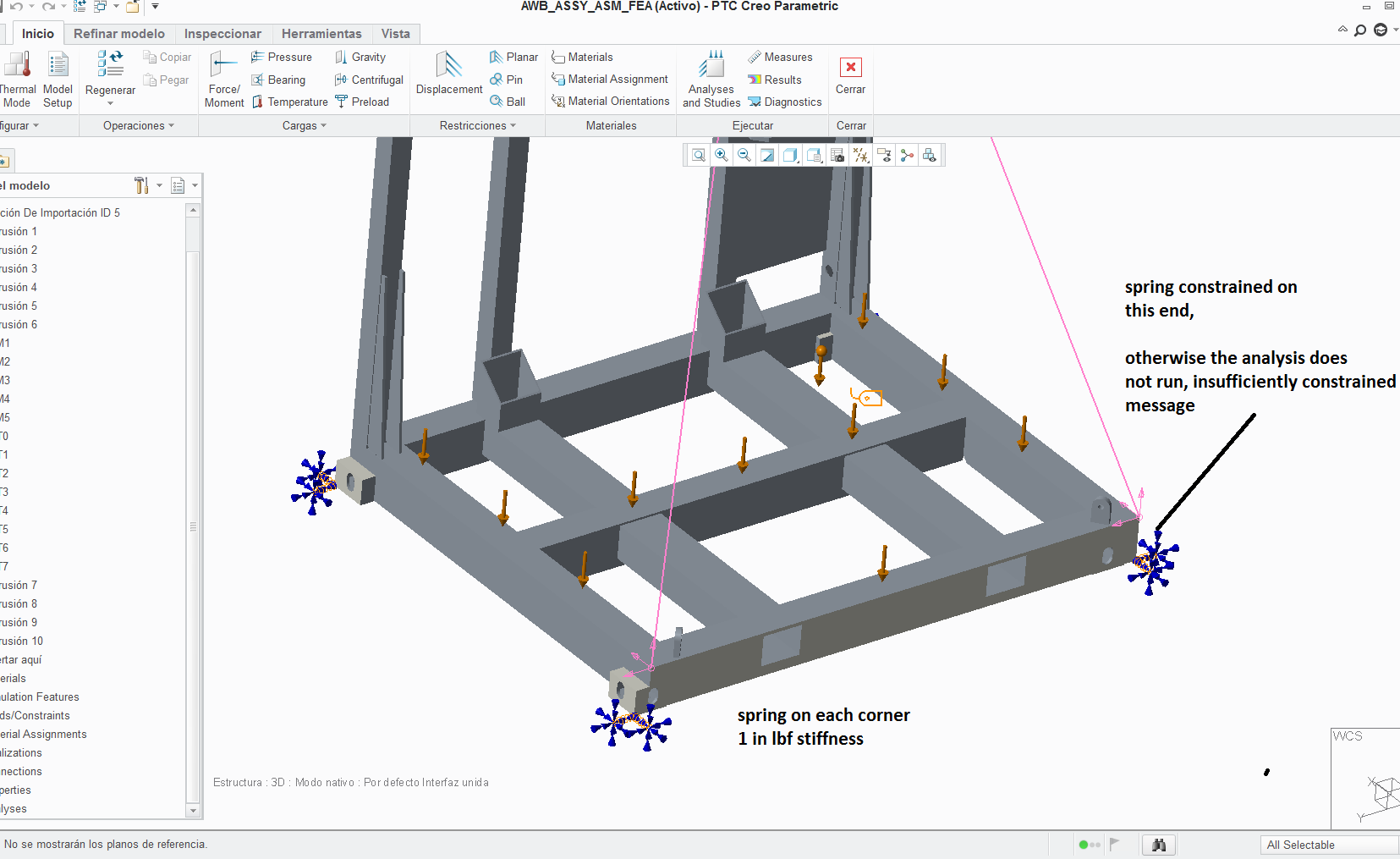
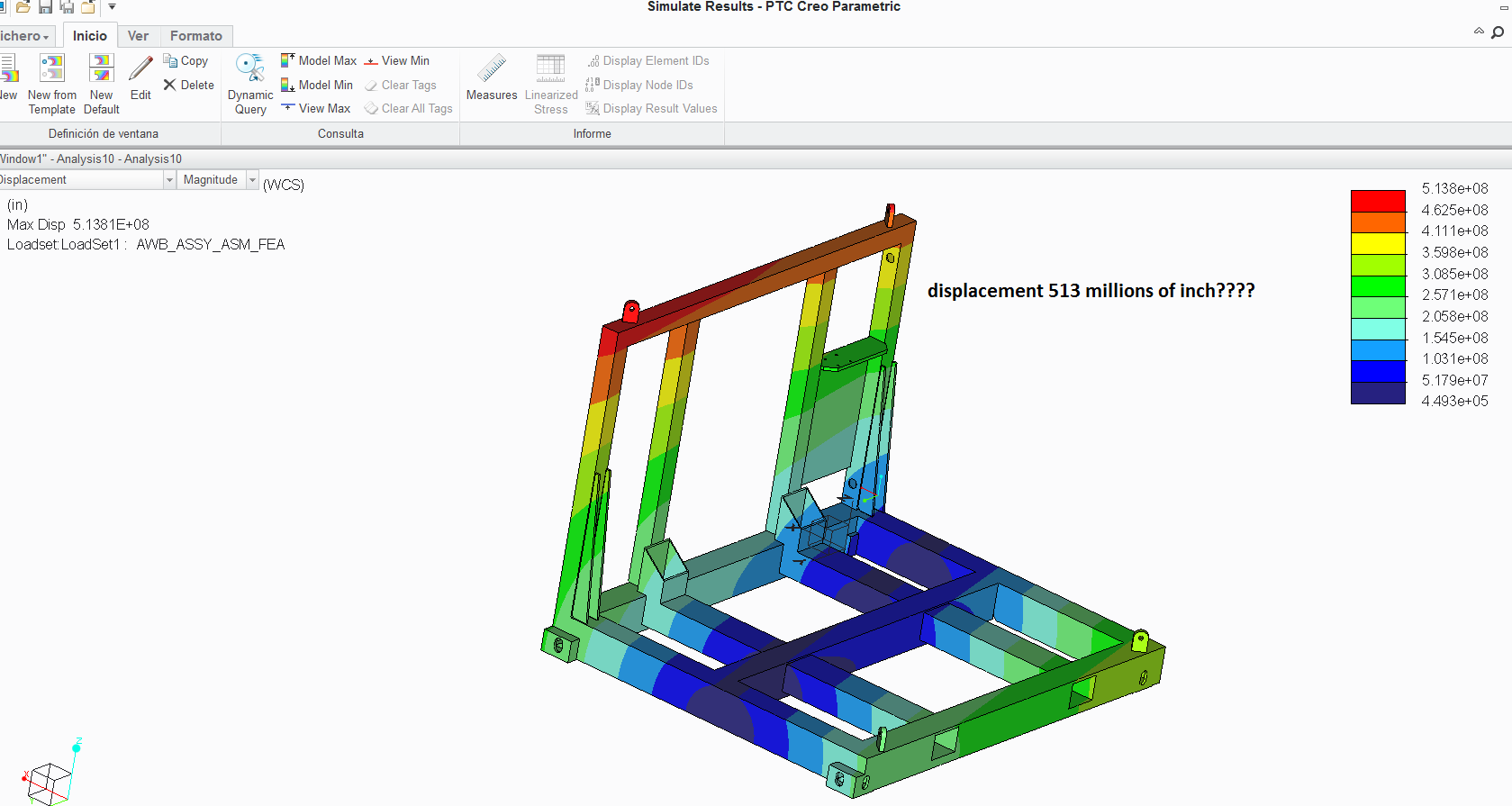
i wonder why on Paul´s example it does not shows any of the springs or planar constrains on the part and it did run (on his machine)
I appreciate your help
regards
- Mark as New
- Bookmark
- Subscribe
- Mute
- Subscribe to RSS Feed
- Permalink
- Notify Moderator
- Mark as New
- Bookmark
- Subscribe
- Mute
- Subscribe to RSS Feed
- Permalink
- Notify Moderator
Paul,
I think the only thing I can add is ... If we want to apply a gravity load then we cannot have inertia relief. So one should remove the load acting on the part such that the inertia relief acts as both gravity and the small accelerations required for balance. The answers are different. Using inertia relief restricts the problem to small deflections and prevents the use of contact (in this case, contact doesn't matter).
I would want to measure the forces at the suspension points to see what errors there were.
why such a fine mesh in your model?
Thanks
Just some general sympathetic thoughts/comments for Antonio otherwise ...
Rotations about the single suspension point are required to achieve balance. These are too big leading to failure insufficiently constrained.
Using light ground springs is a standard technique and one expects it to work. But unless the balance is pretty much perfect initially then the natural subtended movement to an equilibrium position is still too big. Stiffening the springs reduces the movement but then the answers will be wrong, the springs should carry zero load ideally.
We could use large deflection but then we can't use beams, ground springs, weighted links, inertia relief
Modelling cables is problematic as using beams or springs, one cable will carry an unreasonable share of the load whereas in reality the cables would probably pass over a pulley and (ignoring friction) have equal tensions and exchange length. I haven't got a technique for allowing cables to naturally exchange lengths over a pulley(s) and the geometry of the angle of wrap and the point where the cable begins to tough the pulley is not simple. Resorting to contact so that the contact point sorts itself out gets us a little way along another inevitably blind alley because we cannot define a sensible cable material property.
Cables tend to be stiff in tension but not bending/torsion/compression. What material property is that? I tried and failed defining Hyper-elastic material that would have negligible stiffness with negative strain. A transversely isotropic material strong one way but not transversely might be useful but non-isotropic materials cannot be used in large defection studies. Besides, the cable will have the same strength in compression.
We can have 'tension only' springs by using a force deflection curve rather than constant stiffness, ok for fixed length cables (no pulley). A study will be automatically large deflection if a non-linear spring is introduced. Some stiffness must be provided against 'free' rotations else the model will fail and because we cannot have ground springs, simple springs and additional constraints can be used. Exchanging cable length over the pulley is still a problem.
- Mark as New
- Bookmark
- Subscribe
- Mute
- Subscribe to RSS Feed
- Permalink
- Notify Moderator
example attached for gravity load: test 3
fine mesh: symmetrical plot, very good contour plot

but unfortunately: memory usage
- Mark as New
- Bookmark
- Subscribe
- Mute
- Subscribe to RSS Feed
- Permalink
- Notify Moderator
example 4: gravity + ropes (without mass)
regards
paul
- Mark as New
- Bookmark
- Subscribe
- Mute
- Subscribe to RSS Feed
- Permalink
- Notify Moderator
V5: gravity+ropes+springs (ground)
regards
paul
- Mark as New
- Bookmark
- Subscribe
- Mute
- Subscribe to RSS Feed
- Permalink
- Notify Moderator
Paul,
Just to says thanks for the school, I have not been able to review all your examples, I just have been busy with other stuff, as soon as I try any of your suggestions i will post it
Charles,
ok, now for a cable, wire rope or sling remind that it is made of a Steel alloy which could be an isotropic material, however it is made of multiple strands and twisted, so when in tension it sees torsion also, do not ask me what could be those values I have not run in that need yet.
that is why when a sling or rope needs to be certified they check tension strenght, area reduction and condition of the strands..
Thanks
Antonio
- Mark as New
- Bookmark
- Subscribe
- Mute
- Subscribe to RSS Feed
- Permalink
- Notify Moderator
- Mark as New
- Bookmark
- Subscribe
- Mute
- Subscribe to RSS Feed
- Permalink
- Notify Moderator
Paul,
If the beams have all rotational DOFs released at both ends, why don't they spin about their x-axes failing the model?
Charles
- Mark as New
- Bookmark
- Subscribe
- Mute
- Subscribe to RSS Feed
- Permalink
- Notify Moderator
Charles,
i tested it many years ago (example attached).
regards
paul
- Mark as New
- Bookmark
- Subscribe
- Mute
- Subscribe to RSS Feed
- Permalink
- Notify Moderator
Paul,
I was able to get results as per test 5, I am sure it is ok becuase I ran the analysis by hanging my frame at the padeyes hole only ( it has been the way I have analized this cases) and it always matches a third party assesment.
however if I want to get the approval on my own (without a third party assesment) I have to show the ropes, that is why I was wonering how to use that feature, the results are sligtly different with the ropes but those are more real
for some reason as weighted link does not work it says it is insufficiently constrained
Thanks again for the help


